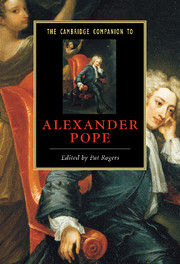Book contents
- Frontmatter
- Introduction
- 1 Pope, self, and world
- 2 Pope’s friends and enemies: fighting with shadows
- 3 Pope’s versification and voice
- 4 Poetic spaces
- 5 Pope’s Homer and his poetic career
- 6 Pope and the classics
- 7 Pope and the Elizabethans
- 8 Pope in Arcadia: pastoral and its dissolution
- 9 Pope and ideology
- 10 Pope and the poetry of opposition
- 11 Crime and punishment
- 12 Landscapes and estates
- 13 Money
- 14 Pope and the book trade
- 15 Pope and gender
- 16 Medicine and the body
- 17 Pope and the other
- Further reading
- Index
7 - Pope and the Elizabethans
Published online by Cambridge University Press: 28 April 2008
- Frontmatter
- Introduction
- 1 Pope, self, and world
- 2 Pope’s friends and enemies: fighting with shadows
- 3 Pope’s versification and voice
- 4 Poetic spaces
- 5 Pope’s Homer and his poetic career
- 6 Pope and the classics
- 7 Pope and the Elizabethans
- 8 Pope in Arcadia: pastoral and its dissolution
- 9 Pope and ideology
- 10 Pope and the poetry of opposition
- 11 Crime and punishment
- 12 Landscapes and estates
- 13 Money
- 14 Pope and the book trade
- 15 Pope and gender
- 16 Medicine and the body
- 17 Pope and the other
- Further reading
- Index
Summary
In narratives of English literary history Pope has tended to be seen as a figure of discontinuity rather than one who finds his natural place in the native tradition. By the end of the eighteenth century, Milton was the acknowledged heir to the poetic inheritance of the age of Shakespeare and Spenser, while Pope represented the triumph of neoclassical refinement after an earlier “barbarity.” In many ways this took Pope at his own valuation: he accepted the prevailing view that the achievement of the Elizabethans was marred by incorrectness, faulty versification and lapses of taste, and that only with Waller, Dryden, and Addison had the English language reached perfection. There certainly could be no return to styles of the past or to an obsolete English. The very title of Pope's The Fourth Satire of Dr. John Donne, Dean of St. Paul's, Versifyed assumes that Donne's poem cannot claim to be “verse” at all. Unlike the ancient writers or those of the Restoration, Elizabethan poets were not his stylistic models, and we look in vain for any acknowledgment, public or private, of the scale of his indebtedness to them.
But a stylistic influence (Waller, say) might be worn more lightly than one that fills the imagination. In his youth Pope read Elizabethan poets, along with much else, during his “great reading period” before the age of twenty-one (Anecdotes, i, p. 20). He read The Faerie Queene at “about twelve” and throughout his life he loved Spenser, for all his obsoleteness of language; later as a translator of Homer he recognised in George Chapman's old version, in spite of its stylistic “Fustian,” “a daring fiery Spirit that animates his Translation” (Anecdotes, i, p. 182; Prose, i, pp. 250-1). Animation in its various meanings is a characteristic feature of Pope's writings at those moments when he is drawing on Elizabethan materials.
- Type
- Chapter
- Information
- The Cambridge Companion to Alexander Pope , pp. 89 - 104Publisher: Cambridge University PressPrint publication year: 2007
- 2
- Cited by

